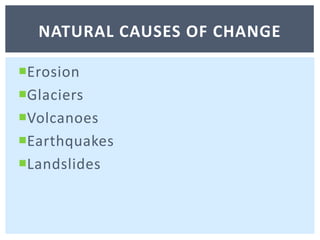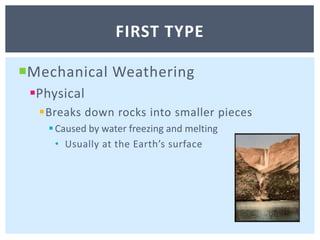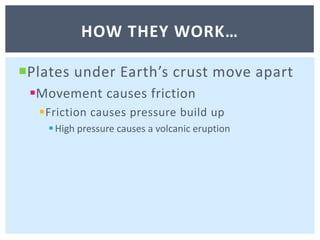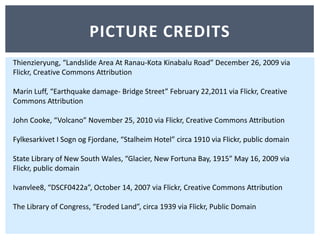Powerpoint project final
- 1. By: Catie McGeeChanges in the earth’s surface
- 3. The Process that breaks things down. Erosion
- 4. After it rains and you go outside to play, you might notice a lot of small rocks and dirt at the bottom of a hill. This is because erosion took place. The water washed the smaller material down the hill. example
- 5. The processes that change the character of rocks at or near the Earth's surfaceWeathering
- 6. Mechanical WeatheringPhysicalBreaks down rocks into smaller piecesCaused by water freezing and meltingUsually at the Earth’s surfaceFirst type
- 7. Chemical WeatheringRock DecompositionRocks are exposed to water and gases Change chemical compounds- form new rocksSecond type
- 8. A large river of ice that moves very slowly. glaciers
- 9. While glaciers move slowly, they carve out the ground. The carving makes valleys. Making of valleys
- 10. A mountain that opens down into a pool of molten rock below Earth’s surface. volcanoes
- 11. Plates under Earth’s crust move apartMovement causes frictionFriction causes pressure build upHigh pressure causes a volcanic eruptionHow they work…
- 13. Shaking at the surface of the Earth because of movement underground along a fault line/volcanic activity. earthquakes
- 14. Determines size of an earthquakeUses seismic waves- A wave that travels through the EarthRichter magnitude scale
- 15. 2.9 and lower Not felt3.0-4.9Felt but little damage5.0-10Felt and a lot of damageRichter magnitude scale
- 16. Rocks and other material sliding down a mountain or cliff.landslides
- 17. Rain- adds weight Erosion- base is removedEarthquakes- loosens materialVolcanic eruption- flowing lavaHumans:MiningDeforestation causes
- 18. California Geological Survey - Kids Zone - Do Rocks Last Forever? . (n.d.). California Department of Conservation - Home . Retrieved February 27, 2011, from http://www.consrv.ca.gov/CGS/inGeography4Kids.com: Biosphere: Erosion. (n.d.).Rader's GEOGRAPHY 4 KIDS.COM. Retrieved February 27, 2011, from http://geography4kids.com/files/lGlaciers. (n.d.). Welcome To Kidskonnect. Retrieved February 27, 2011, from http://www.kidskonnect.com/subject-index/15-science/81-glaciers.htmlEarthquakes - Science for Kids!. (n.d.). Kidipede - History for Kids - Homework Help for Middle School. Retrieved February 27, 2011, from http://www.historyforkids.org/sciKids.Net.Au - Encyclopedia > Richter scale. (n.d.).Kids.Net.Au - Encyclopedia. Retrieved February 27, 2011, from http://encyclopedia.kids.net.au/FEMA FOR KIDS: VOLCANOES. (n.d.). FEMA | Federal Emergency Management Agency. Retrieved February 27, 2011, from http://www.fema.gov/kids/volcanLandslides - Geology For Kids - By KidsGeo.com. (n.d.).Geography For Kids - By KidsGeo.com. Retrieved February 27, 2011, from http://www.kidsgeo.com/geology-for-kids/0071-landslides.phpcredits
- 19. Picture creditsThienzieryung, “Landslide Area At Ranau-Kota Kinabalu Road” December 26, 2009 via Flickr, Creative Commons AttributionMarin Luff, “Earthquake damage- Bridge Street” February 22,2011 via Flickr, Creative Commons AttributionJohn Cooke, “Volcano” November 25, 2010 via Flickr, Creative Commons AttributionFylkesarkivet I SognogFjordane, “Stalheim Hotel” circa 1910 via Flickr, public domainState Library of New South Wales, “Glacier, New Fortuna Bay, 1915” May 16, 2009 via Flickr, public domainIvanvlee8, “DSCF0422a”, October 14, 2007 via Flickr, Creative Commons Attribution The Library of Congress, “Eroded Land”, circa 1939 via Flickr, Public Domain


















